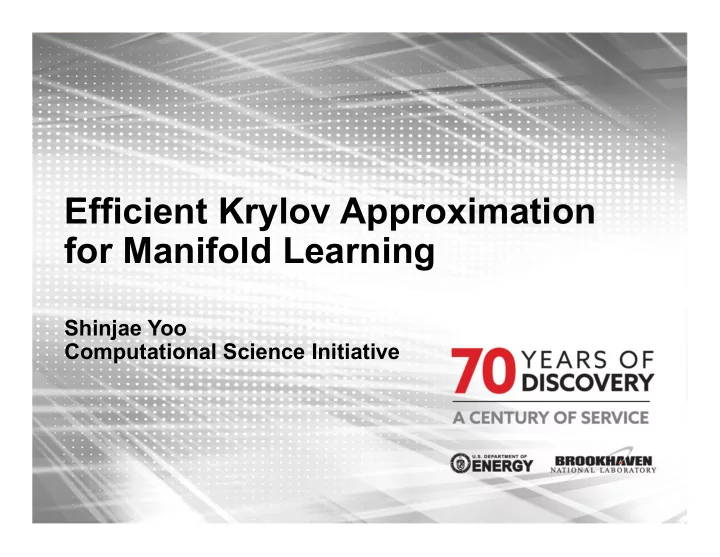

Efficient Krylov Approximation for Manifold Learning Shinjae Yoo Computational Science Initiative
Outline • Projects at BNL • Big data and unsupervised learning • Challenges of manifold learning in Big data • Diverse Power Iteration Embedding • Streaming version 2
Extreme Scale Spatio-Temporal Learning • Fusing theory, simulation, experiments, and ML • Interplay of simulation, observation and ML Long Island Solar Farm 3
Analysis on the Wire • Selectively and transparently perform generic computations on data while in transit in the network fabric. • Process streaming data (e.g., imagery) for early decision-making and reduced downstream bandwidth requirements • Extract data analytics, perform generic computations, use distributed computing capabilities • Examples: Forecasting, deep learning, pattern recognition (e.g., cyber security, automation) 4
Big Data Volume Velocity Variety Veracity 5
Research Facilities Brookhaven National Laboratory RHIC NSRL Computing Facility Interdisciplinary Energy Science Building Computational Science Initiative CFN NSLS-II Long Island Solar Farm Unsupervised Learning Tasks 6
Manifold Learning 7
MapReduce: Not Complete Solution in 2010 • Task : Find cluster patterns in Doppler Radar Spectra • Data : 1hr≈130MB, 1yr ≈1TB, 2004~2008 ≈ 5TB • MapReduce (K-Means) • Map: Find closest centroids • Reduce: Update centroids • MapReduce (Spectral Clustering) • Distributed Affinity Matrix Computation : O(n 2 ) • Distributed Lanczos Methods to compute EVD • Scalability Analysis • 12 cores (1 node) Spectral clustering took 1 week for one month data • 616 cores (77 nodes) Spectral Clustering took less than 2 hours for three months (~300GB)
Power-iteration-based Method n t t t t t v W v a a ... a a a ( i ) t t 0 1 1 1 2 2 2 n n n 1 1 2 i i i 2 2 9 F. Lin, W. Cohen, “Power Iteration Clustering”, (ICML 2010)
Power-iteration-based Method • Limitations 1 st Eigenvector PIE-1 PIE-2 PIE-3 • Large number of cluster application • Limited use of manifolds • Anomaly detection, feature selection, dimensionality reduction 10 Huang et al. ICDM ‘14 and TKDE ‘16
Diverse Power Iteration Embedding (DPIE) t ' v f ' i 1 : k 1 t ' arg min v f k i 1 : k 1 t ' v f f i 1 : k 1 1 3 O ( n ) O ( nmT ne ) 11 Huang et al. ICDM ‘14 and TKDE ‘16
DPIE: Efficient Space Learning Space Efficiency: Cosine Similarity Gaussian Similarity Approximation Affinity matrix W and degree matrix D can be calculated with: Using the equations listed in where 1 is a constant vector of all 1’s, cosine similarity, by replacing and X T denotes the transpose of X. X with R 12 Huang et al. ICDM ‘14 and TKDE ‘16
Diverse Power Iteration Value (DPIV) 13 Huang et al. TKDE ‘16
Diverse Power Iteration Value (DPIV) 14 Huang et al. TKDE ‘16
DPIE: Choice of regression types 15 Huang et al. TKDE ‘16
DPIE: Orthogonalization 16 Huang et al. TKDE ‘16
Experiment • Evaluation Metrics • Clustering and Feature Selection: NMI (Normalized Mutual Information) • Anomaly Detection: AUC Clustering, Feature Selection Anomaly Detection 17
Experiment: Clustering 18
Experiment: Anomaly Detection 19
Experiment: Feature Selection 20
Summary • Clustering: 4000 times faster and reach 95% of the best clustering performance. • Anomaly Detection: 5000 times faster and reach 103% of the best performance. • Feature Selection: 4000 times faster, and has similar performance of the best algorithms. • Provides DPIV and Orthogonalization for various applications 21
Streaming Approximations High Dimensional Stream Feature Selection Clustering Anomaly Detection Feature Selection 22
Questions? 23
Recommend
More recommend